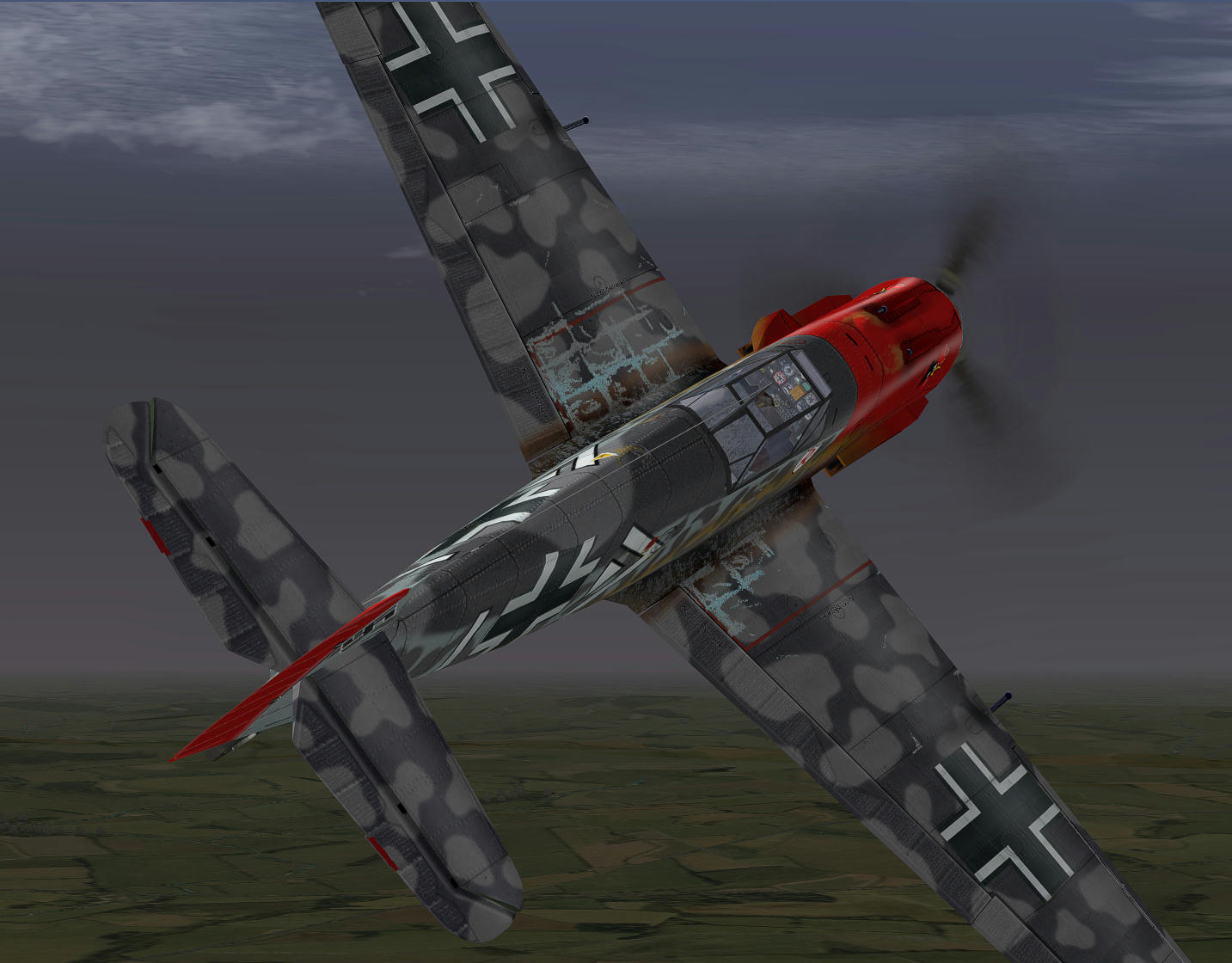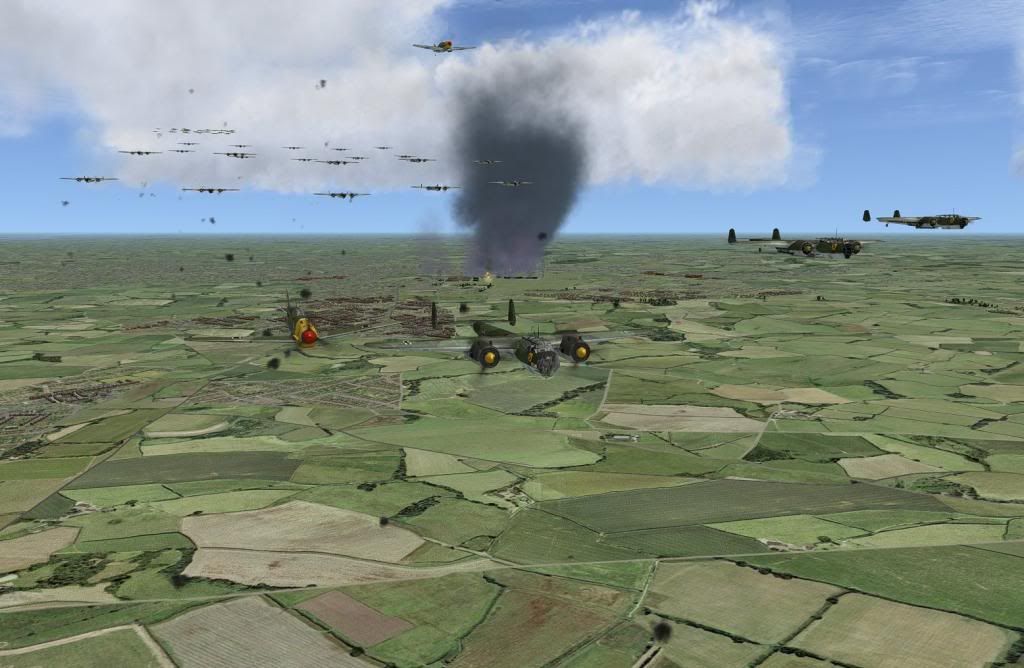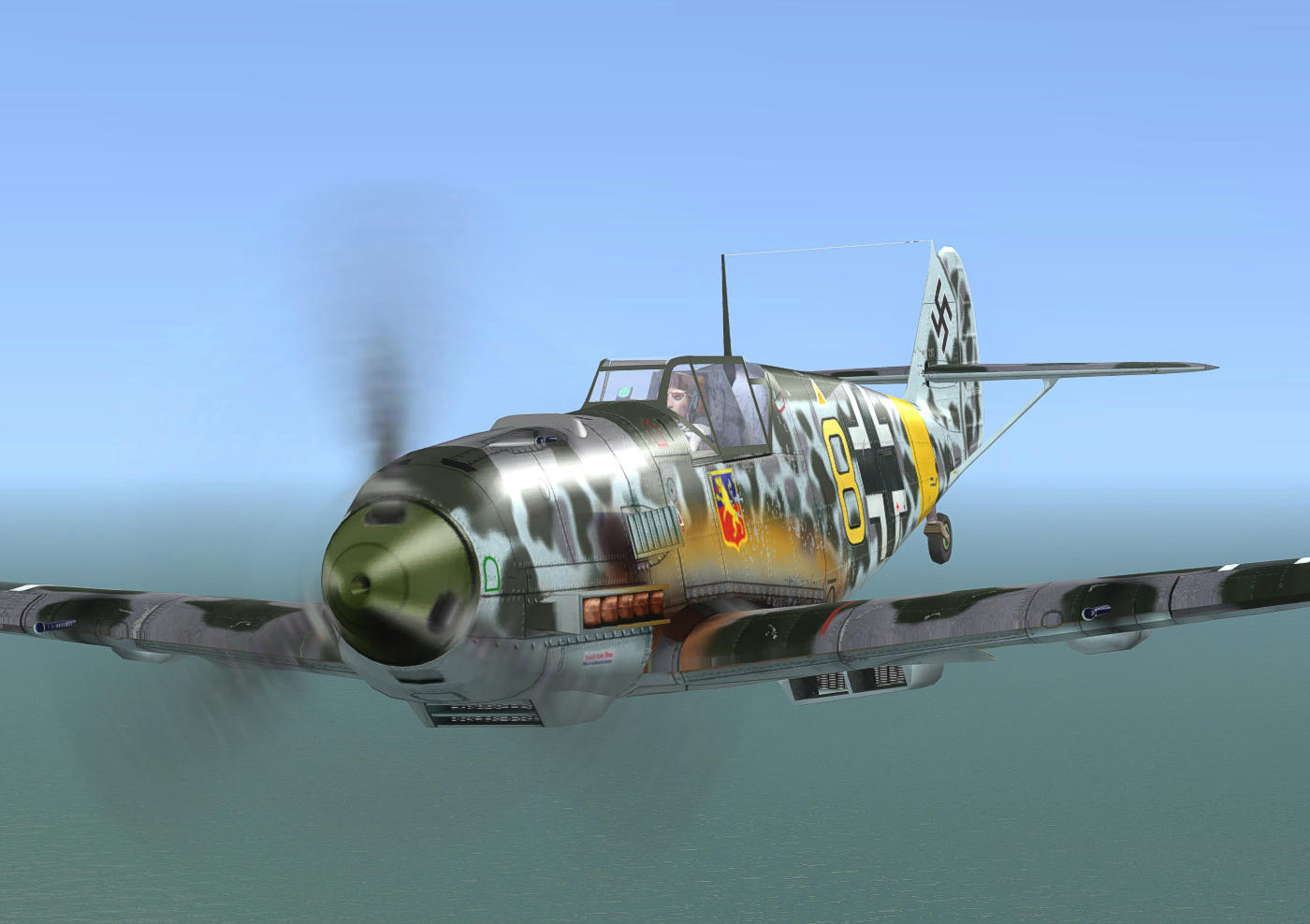'Next Friday' (14 March!)...that is the latest prognostication about release date for Cliffs of Dover Team Fusion Mod 4.2
 In the next TF Mod update, early morning mist effects are back, and you can man the AAA guns to beat off those vulchers!
In the next TF Mod update, early morning mist effects are back, and you can man the AAA guns to beat off those vulchers!
In advance, the team has published the readme, with a feast of detail about new content for the mod:
Updates for TF4.2b:
* Battle damaged and/or shot off parts now comes with a drag penalty, effectively reducing maximum speed.
* Bf110 fuel tanks corrected (but please note that the fuel lamp is still reversed. This will be fixed)
* AI uniforms corrected
* New 3D objects added:
- Blister Hangar (Static->Building->Airfield)
- Dispersal Hut (Buildings->England->Airfield)
Updates for TF4.2a:
* FXAA introduced (just turn it to any other setting than "Off" in your video settings)
* Bf 110 Spinner marking bug corrected
* Flak is now a bit more accurate
* AI pilots "lawndarting" corrected
* Shadows (not trees) should look a bit less choppy (but still). Please keep an eye for any weird shadow introduced by this change
* Redout bug fix (no more pitch black parts)
* Various sound effects has been tweaked.
* Horizon smoke bug fix (no more horizon shining through buildings, trees, cockpit and whatnot)
* Ground fog introduced as in pre-vanilla versions of Clod
* Another horizon bug fixed (smoke no longer get "chopped" at horizon level)
* Re-texture of bf110 cockpit
* Additional bad spawn points fixed
* DCG generator introduced
* BR-20 Top turret fix (no longer inverted)
* FMB option to select both types of empty bomb racks for bf109
* AAA guns can be operated by human player
 Bump mapping has been improved on the Hurricanes, Spitfires and 109s
Bump mapping has been improved on the Hurricanes, Spitfires and 109s
Earlier updates (for TF4.01 versions):
* Windsock now working (see "ground handling" section below)
* Portable air raid sirens now working. (Found in the FMB under Static->Environment/Portable Siren -British/German. It will start sounding when a plane is within 3Km horizontally from where the siren is)
* Added coastal landmarks (see details below)
* Removed gun smoke and contrails from inside the cockpit
* Corrected the ammo lights in all mark of Bf109 and Bf110 (The lights are now ON when there is any ammo left, FLICKERING when firing and OFF when out of ammo (or jammed/destroyed)
* Corrected ammo counter for Bf109E-1B (now works as in the 109E-1, not 109E-3/4)
* Concrete runways made darker in summer and autumn maps
* Brakeshoe0/brakeshoe0 renamed to say brake chocks on/off
* Bail out animations for all marks of Spitfire, Hurricane and Bf109
* Corrections to the Russian translation of German rounds
* Tweaked aircraft reflections algorithms to prevent the whiteout/washout
* Corrected bumpmaps for 109, spit and hurri
* Reduced the moonlight water reflections a bit
* Reduced the night time brightness of the revi sights a notch
* Made a few corrections to night time smoke and water splashes
* Tweaked the aircraft spotting mod a bit by increasing the distance where the aircrafts turn black when using FOV 30 or less (to better enable identification)
* Fixed a small error in the bore of the German AP-H round
* Increased the brightness of tracers a notch
* Increased tracer smoke thickness a notch
* Improved bumpmap of grass fields
* Improved sand texture
* Improved summer map noise texture (bumpmap)
* Added bomb rack options for 109's
* Corrected file format for some aircraft textures
* Corrected slightly off revi sights in axis planes
* Corrections to Spitfire MkI cockpit (boost cut out switch back)
* Added missing markings for 109E-4N-DeRated, Bf-110C-4N-DeRated and Bf-110C-7Late
* LG1 paint scheme fix
* Removed contrail rubber banding under 7000 meters
* Tweaks made to gun dispersions for all fuselage and turret mounted guns (making them slightly more accurate compared to wing and pindle mounts. No guns are made less accurrate)
* Corrected Bf110 turn needle gauge
 Smoke effects are much improved
Smoke effects are much improved
COASTAL LANDMARKS/FEATURES
Added to Channel maps:
Margate Harbour
Margate pier
North Foreland lighthouse
Royal Ramsgate harbour
Deal pier
Folkestone harbour
Folkestone pier
Brighton Palace pier
Brighton West pier
Calais harbour
Dunkirk harbour (correct location)
Canterbury Cathedral (Westminster substitute)
Arundel Castle
Spawn Fixes:
Fixed bad spawns (hangar explosions) at Canterbury airfield & 20+ French airfields
----------------
FLIGHT MODEL READ ME TF 4.2 BETA
The Flight Modeling team has as its motto, "FM's are not perfect, and never will be".
Which means we never stand still, we are constantly looking for ways to improve and refine the virtual aircraft to better replicate the historical ones. Part of this is to do with the learning process we have gone through as we became more familiar with the code, and improve our ability to control the parameters which control the various aspects of aircraft behaviour. It also has to do with the fact we have an ongoing program to re-write the code, to create new parameters and input points which increase the complexity of the aircraft flight model.
The above are the basis of the changes we are introducing in TF 4.2.
----------
OVERALL DIRECTION FLIGHT MODELING
There are two major changes implemented in the Flight Models for TF 4.2:
1) We have gone back and re-examined the Aerofoil polars in detail and where necessary, have made changes which bring the lift/drag characteristics of the game aircraft's aerofoils closer in line with those of the historical aircraft.
2) With some code re-writes, we have focused on introducing more realistic behaviour in the takeoff, landing and ground handling areas of the aircraft envelope. These changes are in the area of flap lift modeling, better refinement of stall behaviour when flaps are down, better refinement of drag characteristics when undercarriage is deployed, more accurate modeling of aircraft handling and Center of Gravity characteristics on the ground as well as more accurate behaviour when under heavy braking.
-------------
1) AEROFOIL CHANGES
All the aircraft types, but in particular the Fighters, have had the Polar values in their .fmd files examined and compared to charts of the historical aerofoil types. There have been a number of changes, which although they do not change the basic maneuver characteristics of the aircraft, do add subtle changes which will clearly affect the way the virtual aircraft respond and game play.
For example, while both Spitfires and Hurricanes will still outturn 109's in sustained turn contests, a 109 with an advantage in energy will be able to turn with either for a brief period. The revised aerofoil of the 109's is more stable at higher Angles of Attack, allowing the pilot to sacrifice speed for turn performance for a brief moment. However, any attempt to maintain the turn angle will very quickly lead to a loss of speed and energy with the Spitfire and Hurricane then rapidly reversing the advantage.
There are no changes in sustained turn times at lower altitudes... in such a contest, the Spitfire and Hurricane have a good deal of an advantage. However, at higher altitudes, in contests between the Spitfire and 109, the higher lift aerofoil of the 109 will begin to reduce the advantage of the Spitfire. There is still an overall better turnrate for the British aircraft, but it is less noticeable the higher the altitude range. This is less the case with the Hurricane, although the Hurricane's comparative powerloading disadvantage at higher altitudes means that although its aerofoil performs better, it is less able to sustain turns.
Players will also notice the Spitfire responds best when its pilot uses a slightly higher speed when turning than was optimal in earlier TF versions. The Spitfire's aerofoil was relatively low lift when compared to the 109, but the wing did have the advantage of low drag, and combined with the aircraft's very low wingloading, this gave the Spitfire its very good turnrate. But this was best achieved with the wing at a lower Angle of Attack, (ie. higher speed) than the Hurricane or 109. The Spitfire still has a good warning 'buffet' to indicate its wing is approaching stall.
Conversely to the Spitfire, players will notice the Hurricane with its new aerofoil characteristics, is better able to sustain higher Angle of Attack turns, is able to pull more steeply into its turns, and that it now has a slightly better maximum sustained turnrate than the Spitfire. However, it does have a sharper stall onset, and pilots who pull a little too strongly will find the aircraft can respond abruptly.
The Fiat G-50 has also had its aerofoil revised. Players will notice the aircraft can be pulled into very tight turn angles, although its low power to weight ratio will not allow it to sustain those angles for long periods. The Fiat can be a handful when pulled into a sharp turn from high speeds, although with practice it can turn very tightly. A G-50 with an energy advantage will quite handily outturn a Spitfire or Hurricane, although it will not sustain turn with them. The G-50 can also display a nasty stall when pushed too far.
The 110 also has had aerofoil changes to bring it in line with the historical aircraft. Once again, the overall sustained turnrate is not much improved, but the 110 aerofoil displays the same characteristics as the 109, (they were closely related) and the aircraft can now be pulled stably to higher angles of attack without it flicking. This means given enough of an energy advantage, the 110 can give a British fighter a bit of a scare. The Bf110 will of course, not turn anywhere near as well as a single engined aircraft, as its weight is nearly 3 times that of 109, Spitfire or Hurricane.
Overall these changes mean the aircraft are closer to what they were historically. A well flown aircraft of any type, in an advantageous position, will be able to get on the tail of its opponent.
109 and 110 Slat Deployment
The Bf109 and Bf110 have also had their slat deployment revised. In TF 4.0 and vanilla, the slats deployed at a lower Angle of Attack than was historically accurate. They deployed at approximately 7 degrees AoA, whereas the actual slats deployed at approximately 8 degrees AoA. What this means in game terms is that as the pilot pulls G into the turn, the slats will deploy a little later than they did in earlier TF versions. As slats deploy, they add additional lift to the outer wing, (where stall typically begins) and prevent overall wing stall from happening as early. But they also cause considerable drag, slowing the aircraft. With the later slat deployement in TF 4.2, the pilot of a Bf109 or Bf110 will now be able to better conduct low G maneuvers at higher speeds, without losing energy due to the slats deploying sooner than they should. There is no difference to behaviour or lift/Drag characteristics once the slats come out.
-------------
Bf110 Rollrate
The Bf110 models have had their rollrates adjusted slightly to better reflect the historical performance. Thanks to Mysticpuma for tracking down a document which shed light on this subject.
-------------
2) TAKEOFF, LANDING AND TAXI CHANGES
UNDERCARRIAGE DRAG
Undercarriage drag has been revised for all aircraft from the vanilla game's generic drag value for nearly all aircraft of 0.7 m2 to drag values based on examination of the actual aircraft's a) length and diameter of undercarriage struts, b) wheel size
Players will notice in general more drag when the undercarriage is deployed.
FLAPS
All aircraft have their flaps operation and effects revised to model the increased drag seen at full deployment. As well, lift characteristics are changed. Both should now show the engineering design focus on:
a) high lift at low AoA
b) increased drag, this combined with a) allowing low landing speeds to be more easily maintained with full control of the aircraft.
Players will note that flaps when fully deployed are now not generally conducive to improving aircraft performance in combat maneuvers. Stall speeds with flaps fully deployed have been set based on known historical data. In some cases where data is unavailable, these speeds have been calculated.
Here are the recommended Approach, Boundary and Flare speeds for the various aircraft in the game with flaps fully deployed and undercarriage down.
NOTE: Pilots should not attempt turns at less than 'Approach' speeds and all turns should be gentle.
For these purposes:
'Approach' is defined as the recommended flight speed in a landing pattern when approaching, or established in the glide path and descending towards the airfield.
'Boundary' is the recommended flight speed when continuing the descent to land, and as crossing the boundary between surrounding terrain and the airfield landing area.
'Flare' is the final speed prior to wheels touching just before the pilot pulls up gently on the stick and causes the aircraft to stall and drop the last few inches onto the runway surface in a three point attitude.
Below figures are with full fuel and loaded weapons, no bombs.
German Aircraft
Bf109's
(speeds may vary slightly with the E-1 a bit lower and the E-4N a bit higher)
Add 5 clicks up elevator trim after flaps and gear are down. Use full fine pitch in Manual.
Approach: 180 kmh
Boundary: 160 kmh
Flare: 150 kmh
Bf110's
(speeds may vary slightly with the C-2 a bit lower and the C-4N a bit higher)
Add 10 clicks up elevator trim after flaps and gear are down. Use full fine pitch in manual.
Approach: 190 kmh
Boundary: 170 kmh
Flare: 155 kmh
Heinkel He-111H and He-111P
Add 10 clicks up elevator trim after flaps and gear are down.
Approach: 175 kmh
Boundary: 150 kmh
Flare: 135 kmh
Junkers Ju-87B
Approach: 175 kmh
Boundary: 160 kmh
Flare: 140 kmh
Junkers Ju-88A
Add 12 clicks elevator up trim after flaps and gear are down
Approach: 220 kmh
Boundary: 200 kmh
Flare: 185 kmh
-----
Italian Aircraft
Fiat BR-20M
Add 10 clicks 'up' Elevator trim. Use 75% rad and 50% oil 2200 rpm and 720mmHG for landing in case of a go round or wave off, and be prepared to use emergency power
820mmHG if this occurs.
Approach: 175 kmh
Boundary: 150 kmh
Flare: 140 kmh
Fiat G-50 Add 5 clicks up Elevator trim. Use 2200 rpm and 740mmHG in case of a go round or wave off and be prepared to use emergency power 840mmHG if this occurs.
Approach: 165 kmh
Boundary: 155 kmh
Flare: 145 kmh
-----
British Aircraft
Spitfire
Use 3000 rpm or fine pitch. Add five clicks up elevator.
Approach: 115 mph
Boundary: 100 mph
Flare: 85 mph
Hurricane
Use 3000 rpm or fully fine pitch. Add five clicks up elevator.
Approach: 115 mph
Boundary: 100 mph
Flare: 80 mph
Blenheim
Add 7 clicks up elevator trim after flaps and gear are down. Use fine pitch and +9 boost in case of go round or wave off.
Approach: 120 mph
Boundary: 100 mph
Flare: 90 mph
-------------
GROUND TAXI, TAKEOFF AND LANDING RUN BEHAVIOUR
In TF 4.2 a lot of work has been done to make Ground handling more accurate. This includes a complete re write of propeller slipstream effects at low forward speeds and how rudder authority is affected by it. In short you will find rudder authority with power on on most types dramatically improved.
GENERAL INFO & TAXIING
You need to take note of the wind direction and strength. Get this from the mission brief or the windsock or smoke from buildings etc.
Taildragger aircraft have a unique combination of Wheel position and centre of gravity. This results in them being a little capricious to handle (esp in crosswind conditions). pilots need to be aware that if you don't control Yaw rates quickly and smoothly then you are setting yourself up for a possible ground loop. To this end you must be "on your toes" and use smooth judicious rudder (and differential brake if need be) to stop swings. Taxy speed is also important a good guide is a walking pace. The faster you go the easier it is to get a swing going that might be uncontrollable. In CLOD nearly all of the aircraft have fully castoring tail wheels .... they have a mind of their own. The only thing that keeps them straight is YOU. Using smooth slow input together with good speed management the aircraft can be accurately manoeuvred on the ground. Airflow from the prop has a significant effect on rudder authority the more prop wash the more rudder authority ... but also the more Torque and spiral slipstream effect to counter. So it requires intelligent co-ordinated pilot input to keep things under control. A small trickle of power should be enough for most types to keep then straight under most realistic wind conditions. For tight manoeuvring on the ground keep speed right down use full rudder and differential brake and moderate power. If the swing is accelerating get on to it ASAP, come off the brake immediately and ease off the rudder input.... maybe even reverse the rudder input and apply opposite brake. Taxy with Full back stick in. If you think the rudder is lacking authority at slow speeds a little Blip of power will help slipstream wise.
TAKE OFF
Some aircraft need a some specific techniques in high crosswind conditions .. notably the BF109/Spitfire and Blenheims. Guidance is given later.
Get the aircraft lined up on the runway pointing exactly down the centreline. If you have turned on to the runway through a large angle there is every chance the tailwheel is offset from the fore aft axis. taxi forward a little to ensure its straight. If required use the “brake Shoe/Chocks option”. Note the direction of the wind from the windsock …. this is vital. A wind from the right is the most critical as it adds to the torque effects. At 6msec crosswind consider pre selecting full opposite rudder. (i.e. wind from the right set full left rudder). On all types once you get above 40MPH/80Kmh you should easily have enough rudder authority to control any swing. When you advance the power do it smoothly and progressively .... get on to any directional changes ASAP with small but prompt smooth rudder work.
If the swing is becoming difficult to control cease any increase in power (or reduce the application rate) until you have things under control... then re introduce the power. Avoid use of Differential brakes unless absolutely necessary. (Differential brake during taxi use is however a prime control method). With crosswind component 6msec or greater then up to full into wind aileron may be required on the narrow track types (Spit and 109)
As you rotate gradually ease the aileron input off …. i.e just maintain wings level. Once safely off the ground ease the rudder off and centre the skid ball.
BLENHEIM CROSSWIND TAKEOFF SPECFIC TECHNIQUE
This is the most difficult of the current CLOD aircraft, but if done properly quite manageable.
The worst scenario is a limit crosswind from the right as this is additive to torque effects.
With limited airflow over the rudder until 40MPH care is needed.
there are a couple of ways to handle it though this is IMO the easiest.
This based on 6Msec crosswind worst case from the right
PRE Take off checks
Boost Cut Out ON
Props Full Fine
Rudder Trim neutral or 1/2 opposite Crosswind (Pilots choice)
I would not recommend more than half rudder trim as it complicates
the lift off case.
1. Rudder trim Neutral or 1/2 opposite crosswind
2. Chocks in or brakes on
3. Pre select full opposite Rudder
4. Advance both engines to +5lbs Boost
5. Release brakes and advance into wind engine to +9 Boost
6. Passing 40MPH advance other engine to +9
7. normal take off
BF109 CROSWIND TAKEOFF SPECIFIC TECHNIQUE
the BF109 narrow and high gear make it a little awkward on take off.
6Msec crosswind should be considered a hard limit.
Note the wind direction and speed.... look at the windsock
Hold the aircraft on the brakes or have the “ground shoes/Chocks” in place
Pre select Full into wind aileron.
Slowly apply power keeping the aircraft straight with smooth but positive Rudder input.
As IAS builds past 80kmh you may start reducing aileron input... dont pre-judge this but react to what you see and feel … basically keep the wings level. As you get airborne again ease of the aileron to keep wings level. Once airborne Ease of the rudder and center the skid ball.
SPITFIRE CROSWIND TAKEOFF SPECIFIC TECHNIQUE
Similar to the 109 but not as critical. You wont need as much into wind aileron.
LANDING
Know what the wind is and where its coming from … look at the windsock smoke etc. Use this to plan your landing. Approach airspeed and touchdown without skipping and landing with zero drift (i.e. pointing exactly down the runway) are important means to stay safe. If you touch down with ANY drift on you will encounter an immediate swing that needs controlling .... don't set yourself up. Likewise slack control of Airspeed on final increases your chance of a skip/bounce... this then introduces the possibility of getting a little bit of drift on before the final touchdown. So do that "Pilot shit" nail the Airspeed, nail the runway centreline, arrive in the three point attitude. Once under control bring the control column fully back and commence braking as required. Keep the wings level with aileron as required (up to full into wind aileron might be required with the spit and 109). You will be able to use the brakes a lot earlier and harder now then previously. It is still possible to nose over but generally only if you get on the brakes immediately after landing before getting the tail down ... thats why a 3 point landing is desired.
Know the wind if landing at an all over grass field then land into wind. If you are using a fixed runway direction and it is becoming difficult or at limit crosswind then consider diversion to a grass all over field or airfield with a more into wind runway. So A good knowledge of airfields around you is helpful. (VO101_Toms airfield diagrams are invaluable in this regard)
TAIL WHEEL LOCKS
The only aircraft in CLOD at present with Tail wheel locks are the JU87,JU88 and BR20 (new in 4.01). These can be used any time on long straight legs and SHOULD be used for take off and Landing. On take off once lined up and with the tail wheel straight Lock the tail wheel. On landing verify the Tail Wheel is locked. After landing when down to a walking pace and ready to taxi off the runway un-lock the tailwheel. The tail Wheel will not lock unless the tail wheel is aligned with the aircraft's fore aft axis.
CHOCKS ..... BRAKESHOES
CLOD TF4.01 now can use the Brake Shoes or Chocks feature more realistically. You may need to set a keybinding for this. This simulates the Ground crew either placing or removing Wheel chocks. It will only work at zero forward speed. It is of particular use in during Engine Warm up in strong wind conditions, or on line up prior to take off …. though perhaps a little unrealistic in this phase. The Options settings refers to this as "Brakeshoes". In Game the Blue status message now shows "Chocks IN" or "Chocks OUT"
BRAKING
Progressive braking (i.e. on a slider) has been enabled for all RAF types and the Fiat G50 and BR20. This allows progressive application of Braking pressure, Differential distribution to each unit is still controlled by rudder deflection. Differential braking is an integral part of ground handling in these types. You will be using it a lot more than previously especially in the low speed case.
CROSSWIND
Mission designers need to consider crosswind limits. These aircraft all had crosswind limits in the order 5-6 msec maximum. Not a big deal on Grass all over fields as you just land and take off into wind. Sealed runways however will pose a problem if the crosswind is excessive so be considerate. Most sealed runways are actually designed and laid down pointing along the axis of the statistical average wind. Mission designers should start using the Windsock strong object and place it somewhere logical where pilots can see it. A White X banner under it helps a lot in this area.
WINDSOCK
The windsock Strong object has been tweaked to reflect the practical crosswind limits we now have in TF4.01. The graphic below illustrates the Wind strength versus Sock deflection. At 10msec or more the Windsock will be horizontal.

PRACTICE
This new Ground handling will require practice. Dont expect to have it totally under control right from the get go. initially you may find it frustrating especially if wind is present. These aircraft could be a handfull/bootfull on the ground. Practice practice and you will get the hang of it.
------------
AI Aircraft Flight Behaviour
Some re-writing of the AI routines governing aircraft behaviour at low altitudes. This should reduce the incidence of 'Lawn-Darting'.
The changes however, will not eliminate this from occurring, and I would recommend Mission Builders use the following values for default Skill levels in their mission files.
Rookie: 1 0.47 0.21 0.053 0.053 0.21 0.053 0.053
Average: 1 1 0.74 0.21 0.11 0.74 0.11 0.32
Veteran: 1 1 0.74 0.21 0.21 0.74 0.32 0.32
Ace: 1 1 1 1 1 1 0.89 1
----------
New Aircraft
109E-4N-DeRated
110C-4N-DeRated
These two aircraft are the same as the standard versions of these aircraft with their DB601N engines, but have WEP power disabled to represent the 'DeRating' of the engine allowable power settings which occurred on or around the time of the Battle of Britain.
They have the same performance as the fully rated types at the 1.35ata power setting.
These are made available so Mission Builders can have the option of selecting either type. For reference, although there is not a lot of hard data on the dates when the aircraft had the max power settings reduced, it is likely the WEP enabled versions were operating at latest after mid October of 1940, when factory data indicated 110E-1N models under testing at that time were using 1.42ata.
In addition, the standard 110C-4N now has 1.42 ata WEP power enabled.
---------
Radiator Puncture and Drain times
All aircraft have had their radiator drain times revised to better reflect the historical average. This change will see radiators taking slightly longer to drain after being hit by gunfire.
----------
109E-4N and 110C-4N Overheat
The 109E-4N and 110C-4N have their overheat schedules revised to better reflect their cooling characteristics.
----------
Merlin III Engine Overheat
British Aircraft equipped with the Merlin III engine have their overheat characteristics tweaked to better reflect the 5 minute power setting restrictions. Pilots will be better able to sustain full boost and rpm in level flight maximum speed situations, but should exercise caution when using the same settings in low speed, high Angle of Attack maneuver and should monitor their temperature gauges.
----------
Spitfire IA 100 octane Sea Level Speeds
Spitfire IA 100 octane variants have their sea level maximum speeds raised to the historical 310 mph level.
----------
Spitfire IIA Sea Level Speeds
Spitfire IIA variants have their sea level maximum speeds reduced slightly to historical levels.
---------
Hurricane I Rotol 100 octane Sea Level Speeds
Hurricane I Rotol 100 octane variants have their sea level maximum speeds reduced slightly to the historical levels.
----------
Variable Prop Pitch Climb Exploit Fix
British aircraft equipped with Variable Prop Pitch types have been open to an exploit at higher altitudes. In TF 4.0, the Spitfire I's and the Hurricane DH5-20's were able to use higher than actual climb rpms without a concern for overheating.
While it is not a perfect fix, for the moment we have addressed this by reducing the allowable maximum safe rpms for these aircraft. The Spit I's and Hurricane DH5-20's are now limited to 3100 rpm. Players will not notice a large effect in normal flight, but in steep dives, will need to reduce throttle as they approach terminal velocity. Exceeding max. allowable rpms for any length of time will cause engine destruction.
We hope to institute a more permanent and accurate fix when the overheat modelling systems are revised for TF 5.0.
---------
Fiat G-50 revised Climb, Rollrate, Speed and Overheat model
The Fiat G-50 has had a complete revision of its engine, overheat and roll characteristics.
Also translation fixes including:
superficie del piano stabilizzatore -- translation: "surface of the stabilizer" Horizontal Stabilizer
superficie del timone di quota -- translation: "rudder area to share", this is actually the elevator not the rudder
superficie del piano di deriva -- translation: " the surface of the drift" This is the fin
superficie del timone di direzione -- translation: "surface of the rudder" This is the rudder
The original developers had given the G50 overly large fin, rudder, stabilizer and elevator area. As well, the ratio between the fixed surfaces and moveable ones were out of balance. All which resulted in an overly stable and sluggish aircraft. The change to historical values results in a much more harmonized set of controls. In addition, the developers had undersized the ailerons, the game values were 1.3 m2 instead of 1.52 m2 in the real aircraft. The change to correct values gives better rollrate performance.
After entering the correct values, the game aircraft now better reflects the historical aircraft, characterized as underpowered, but very maneuverable within its optimum maneuver envelope of 300 - 350 kmh
Overheat, Climb times and Speeds now more precisely match the original documents.
The G50's 12.7mm Breda Safat Machine Cannon have their sound effect replaced with one which is more characteristic of the type and the engine sound is deepened.
---------
Stuka, Ju88A and Blenheim default Trim settings
The Stuka, Ju-88A and Blenheim have had their default aileron trim setting revised to better stabilize the aircraft in level flight.
---------
Ju-87b Stuka Flight Model
After the discovery the original game did not model drag for fixed position undercarriages, our coders created a mod to allow this.
Climb, Speed, Overheat, Stall and Aerofoil characteristics were then adjusted to take into account the
changed drag factors and to align the aircraft performance with known data.
--------
Ju-88A, Heinkel 111H and P and BR-20M revised Climb, Speed and Overheat characteristics
There are too many changes to go into detail, but all of the above aircraft in a similar fashion to the Ju-87, have had their Climb, Speed, Overheat, Stall, Aerofoil and general performance revised to TF 4.01 mod standards from where they were in TF 4.0.
These changes bring the bomber and Attack types up to the level of accuracy of the Fighters.
---------
Ju-88A Fuel loads and unloaded weight
Fuel loads in the Ju-88A internal tanks have been corrected to amounts carried by the historical aircraft. The game had incorrectly given the aircraft internal fuel equivalent to the amount carried by both internal tanks as well as the amount which could be carried in optional droppable or jettisonable tanks which historically could be mounted in the bombbay or on the wings on the bomb racks. (these are not available currently in the game)
Fuel load is now 415 liters for the outboard internal tanks and 425 liters for the inboard internal tanks.
The vanilla game had also incorrectly reduced the unloaded aircraft weight to artificially compensate for all the incorrect amount of extra fuel carried, the aircraft now has the correct historical unloaded aircraft weight.
---------
BR20M Autopilot, Pneumatic pressure, and Carburetion
The BR20M has had its autopilot generator switched to run off an engine, in order to eliminate the vibration bug which affected it. The aircraft's carburetion has also been modified to allow it to use maximum rpms and boost.
---------
Brakes on incremental controls
Any aircraft which were incorrectly equipped in the game with toggle 'on/off' Brake systems have had them changed to incremental control types.
---------
Increased Drag from Combat Damage
Aircraft with combat damage will now suffer increased drag effects from the damaged parts. This will eliminate some of the anomalies seen in TF 4.0, with aircraft with combat damage seeming to be unaffected.
----------
Gunner Positions G Effects and Reload times
Aircraft gunners are no longer subject to the 5G restriction for firing weapons. This affects both human gunners and AI gunners. Aircraft gunners will now be much more dangerous and accurate opponents.
Aircraft Gunners in upright or seated positions now have their magazine reload times reduced to 8 seconds.












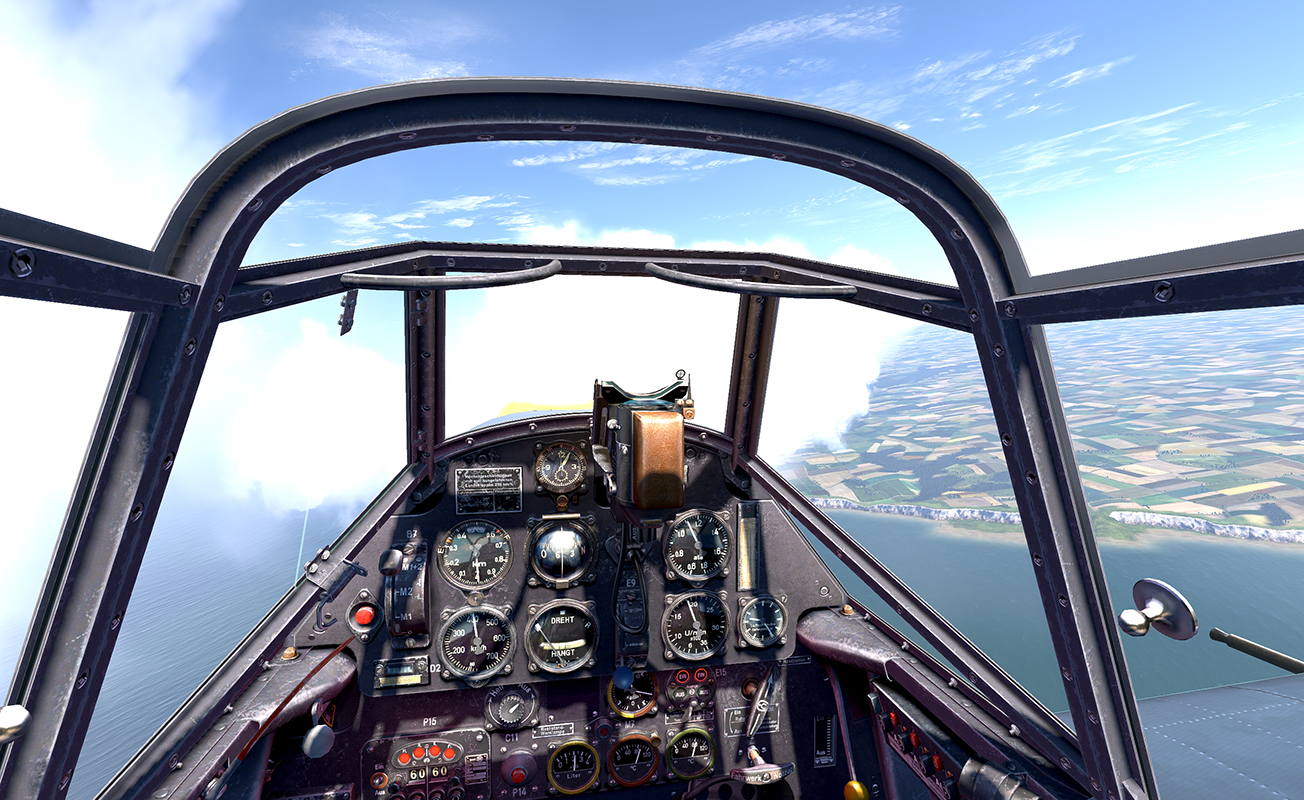
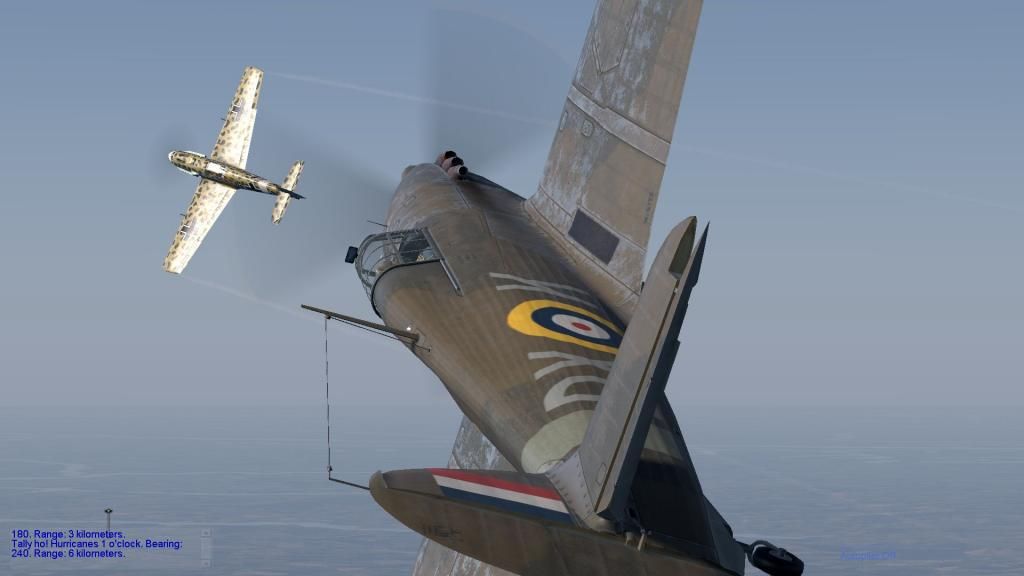
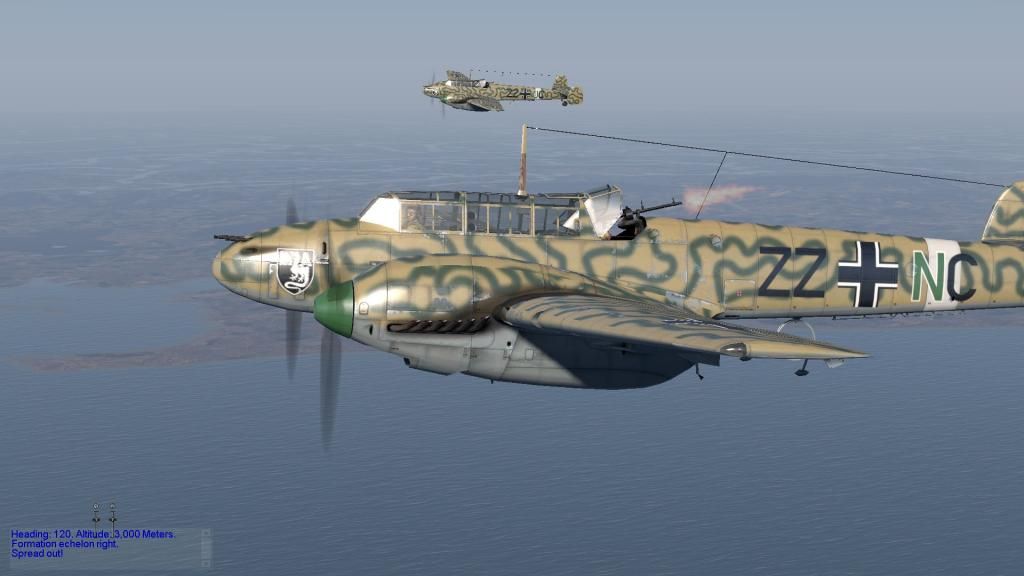

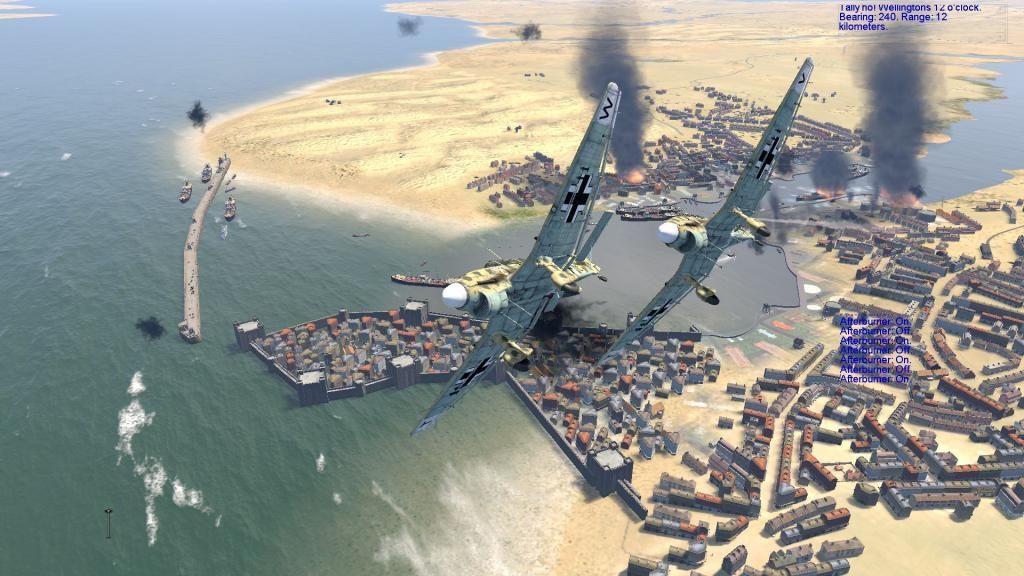


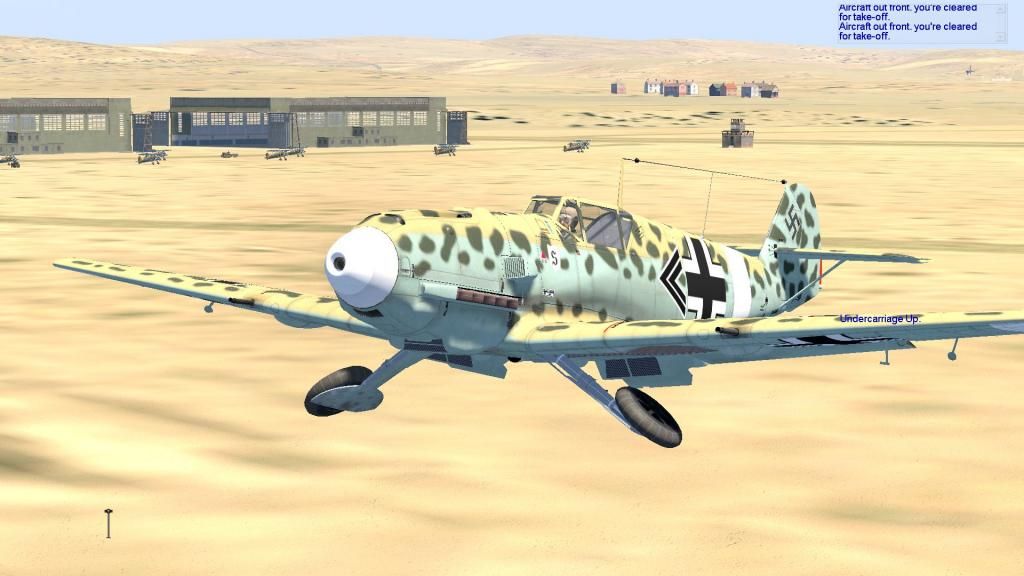
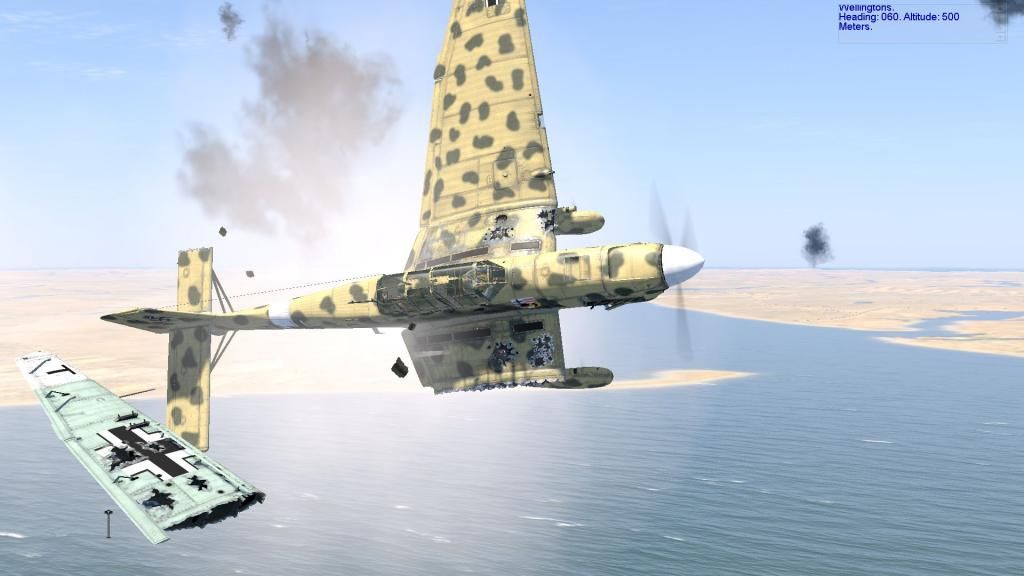

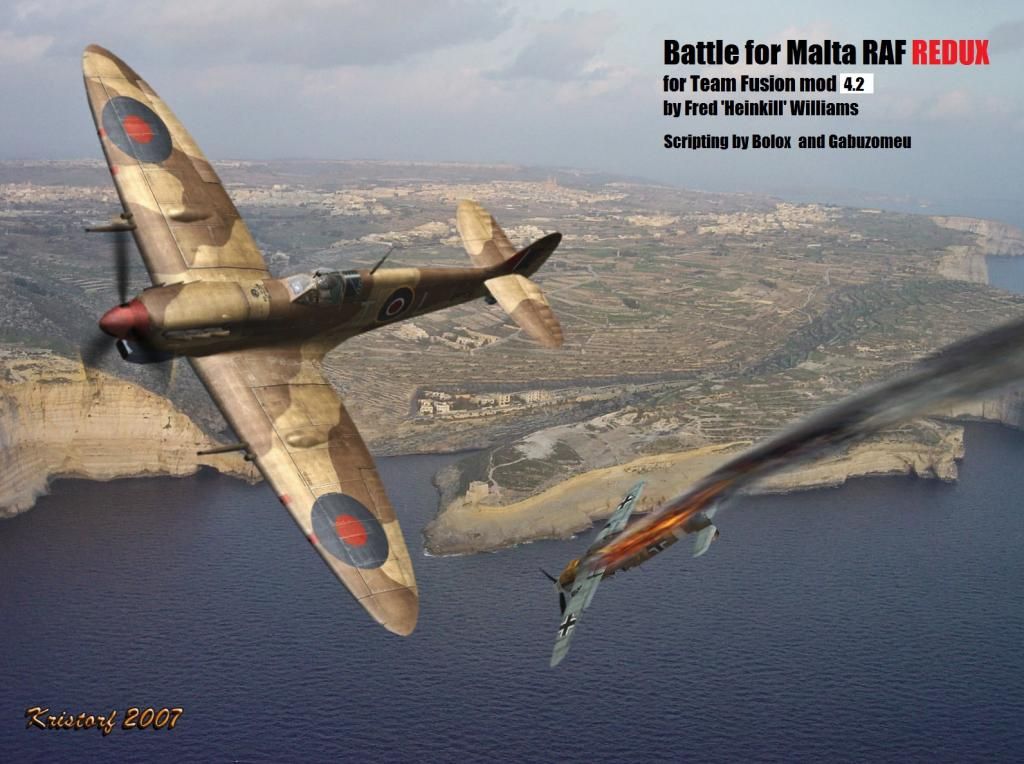
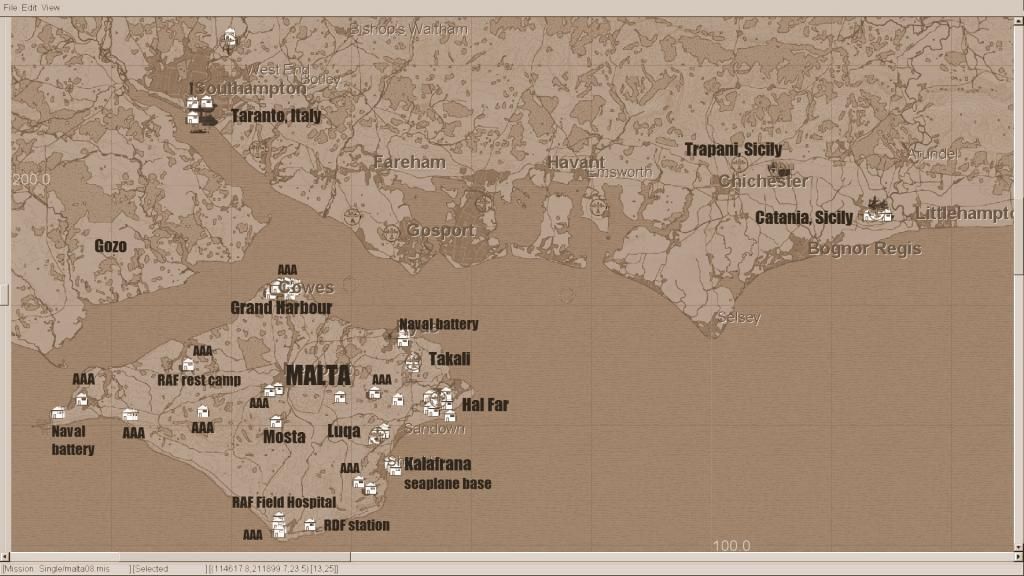







![[All illustrations by Mike Caplanis, ©2014]](http://www.historynet.com/wp-content/uploads/image/2012/AVH/AVHP-140500-AMAZING-spit.jpg)







